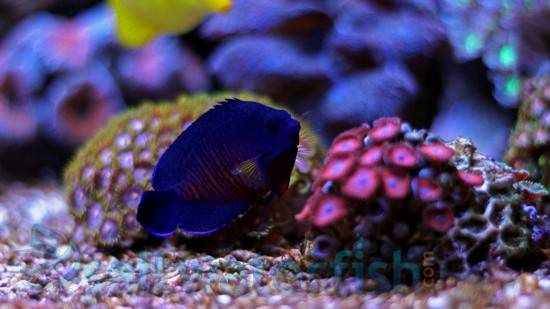Lemonpeel Angelfish - Fiji
Centropyge flavissimus
(0 Reviews)

Lemonpeel Angelfish - Fiji
Centropyge flavissimus
(0 Reviews)
{{ item.name }}
Size: {{ item.extra_field_3 }}
${{ getFormattedPrice(item.saleprice) }} ${{ getFormattedPrice(item.price) }}
To join the waiting list, click here
Free Shipping
With
$199.00
or more in Marine Life.
More details...
Lemonpeel Angelfish - Fiji Care Facts
| Care Level: | Moderate |
|---|---|
| Temperament: | Semi-Aggressive |
| Diet: | Omnivore |
| Reef Safe: | No |
| Minimum Tank Size: | 70 gallons |
| Max Size: | 6 inches |
Lemonpeel Angelfish (Centropyge flavissima): A Comprehensive Guide for Saltwater Marine Aquariums
The Lemonpeel Angelfish, scientifically known as Centropyge flavissima, is a dazzling addition to saltwater marine aquariums, cherished for its vibrant coloration and striking appearance. This educational guide will delve into the essential facts about this species, their care requirements, and why they make an excellent choice for marine enthusiasts.
Habitat of the Lemonpeel Angelfish
Lemonpeel Angelfish are naturally found in the Indo-Pacific region, specifically in the Western Pacific Ocean, covering areas such as Fiji, Indonesia, and the Solomon Islands. They inhabit coral reefs and rocky crevices, often seeking shelter among the branches of coral formations.
Reef Safety of the Lemonpeel Angelfish
Lemonpeel Angelfish are not considered reef safe. They are known for coral-eating behavior; they may occasionally nip at small-polyp stony corals (SPS) and certain soft corals. Monitoring their interactions with corals in the aquarium is advised.
Size and Lifespan of the Lemonpeel Angelfish
Adult Lemonpeel Angelfish typically grow to 4 to 5 inches (10 to 13 cm) in captivity.
Lifespan and Diet of the Lemonpeel Angelfish
Lemonpeel Angelfish can live for approximately 5 to 7 years with proper care and a suitable environment. In their natural habitat, Lemonpeel Angelfish feed on a diet primarily consisting of algae, zooplankton, and detritus. In captivity, providing a balanced diet that includes marine-based flakes, pellets, frozen foods, and live or frozen algae sheets (seaweed) is crucial. Ensuring a variety of food sources will help maintain their health and vibrant coloration.
Aquaculture Availability of the Lemonpeel Angelfish
While aquacultured Lemonpeel Angelfish are occasionally available, they are less common than their wild-caught counterparts. Selecting responsibly sourced individuals is essential for ecological sustainability and the health of the fish.
Sexual Dimorphism in the Lemonpeel Angelfish
Lemonpeel Angelfish do not exhibit significant sexual dimorphism, with males and females displaying similar external characteristics.
Symbiotic Relationships of the Lemonpeel Angelfish
These angelfish do not engage in symbiotic relationships with corals, anemones, or other marine organisms. Their primary role is to graze on algae, contributing to the overall health and appearance of the aquarium.
Juvenile vs. Adult Coloration of the Lemonpeel Angelfish
Juvenile Lemonpeel Angelfish boast a striking and vibrant yellow coloration, making them particularly attractive to hobbyists. As they mature into adulthood, their coloration may shift slightly, with the addition of blue highlights along their dorsal fin and eye-catching electric blue margins on their pectoral fins.
Compatibility and Temperament of Lemonpeel Angelfish
Understanding the compatibility of Lemonpeel Angelfish with other tank inhabitants is vital to maintaining a harmonious aquarium environment. They are generally peaceful but can occasionally display territorial behavior towards their species or similar-looking angelfish. Therefore, providing ample hiding spaces and visual barriers within the aquarium is crucial.
Suitable Tank Mates for the Lemonpeel Angelfish
Here are five specific species that are known to coexist well with Lemonpeel Angelfish:
- Royal Gramma (Gramma loreto): Peaceful and visually striking, they make good tank mates.
- Clownfish (Amphiprion spp.): Clownfish are generally compatible with angelfish and add a lively presence to the aquarium.
- Firefish Goby (Nemateleotris spp.): Peaceful and eye-catching, they are suitable companions.
- Yellowtail Damsel (Chrysiptera parasema): These small damsels are typically non-aggressive and can coexist harmoniously.
- Six-Line Wrasse (Pseudocheilinus hexataenia): These wrasses are known for their active and peaceful nature.
Tank Requirements for the Lemonpeel Angelfish
Creating a suitable environment is crucial for the well-being of the Lemonpeel Angelfish and their potential anemone or coral companions. Here are the key tank requirements:
- Tank Size: A tank with at least 70 gallons capacity is recommended for housing a single Lemonpeel Angelfish. Larger tanks are necessary when keeping multiple angelfish or other species.
- Aquascaping: Provide ample hiding places and live rock structures to create territories and minimize potential aggression.
- Water Conditions: Maintain stable water parameters with the following guidelines:
- pH: 8.1 to 8.4
- Salinity: 1.023 to 1.025
- Water Temperature: 72°F to 78°F (22°C to 26°C)
- Water Flow: Moderate to strong water flow, replicating their natural reef habitat.
Other Common Names for the Lemonpeel Angelfish
Lemonpeel Angelfish are also known as Lemonpeel Dwarf Angelfish or Yellow Angelfish.
Why Choose the Lemonpeel Angelfish from Saltwaterfish.com
Selecting the Lemonpeel Angelfish from Saltwaterfish.com ensures you receive healthy and acclimated specimens. Our commitment to responsible sourcing and ethical practices ensures you make an environmentally conscious choice. With our vast experience in the marine industry, Saltwaterfish.com offers a reliable source for marine enthusiasts seeking these captivating and colorful angelfish.
In conclusion, Lemonpeel Angelfish is a brilliant choice for saltwater marine aquariums due to their stunning yellow coloration, peaceful temperament, and compatibility with reef tanks. Their algae-grazing behavior contributes to a cleaner aquarium and enhances its aesthetic appeal. To provide them with a thriving and vibrant home, meeting their specific care requirements and choosing compatible tank mates is essential.
Beautiful fish, adds some color to my aquarium. Very happy with him.
Reviewed by: Danny Cowan on Dec. 8, 2024
Reviewed by: Marcus Smith on Aug. 4, 2024
Reviewed by: Harold Hoffman on Aug. 24, 2023
Angel arrived healthy and ready to eat. What more can you ask for?
Reviewed by: Scott Quinn on Aug. 22, 2023
Reviewed by: Cedric Hills on Aug. 7, 2023










